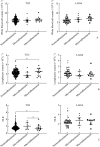Clinical value of lymphocyte count in autoimmune diabetic nephropathy
- PMID: 38432854
- PMCID: PMC10929952
- DOI: 10.11817/j.issn.1672-7347.2023.230110
Clinical value of lymphocyte count in autoimmune diabetic nephropathy
Abstract
Objectives: In recent years, the prevalence of diabetic nephropathy (DN) has increased significantly. An increasing number of studies have shown that lymphocyte-associated inflammatory responses play a role in DN. This study aims to investigate the relationship between lymphocytes and DN in patients with autoimmune diabetes.
Methods: The clinical data of 226 patients with Type 1 diabetes (T1D) and 79 patients with latent autoimmune diabetes in adults (LADA) were retrospectively studied and stratified according to the urinary albumin to creatinine ratio (ACR). Risk factors associated with DN were analyzed using correlation analysis and logistic regression.
Results: In T1D and LADA patients, systolic blood pressure (SBP), uric acid duration, and diabetes duration in patients with normoalbuminuria were lower or shorter than those in patients with macroalbuminuria (P<0.05). The lymphocyte count of T1D patients was significantly higher than that in LADA patients (P<0.05), while the neutrophil to lymphocyte ratio (NLR) of T1D patients was significantly lower than that in LADA patients (P<0.05). The lymphocyte count in the T1D patients with normoalbuminuria was lower than that those with macroalbuminuria (P<0.05). The NLR was lower in the T1D patients with macroalbuminuria than those with microalbuminuria and normoproteinuria (all P<0.01). Based on logistic regression analysis, lymphocytes were independently associated with DN in T1D after adjusting for various known risk factors such as course of disease, age, gender, dyslipidemia, hypertension, and smoking status. Analysis of the receiver operating characteristic curve of subjects predicting lymphocytes in normoalbuminuria showed that the area under the curve was 0.601 (95% CI 0.510 to 0.693, P=0.039), and when the cutoff value of lymphocytes was 2.332, the sensitivity was 37.0%, and the specificity was 82.5%.
Conclusions: Lymphocyte counts in autoimmune diabetic patients are closely associated with DN, suggesting that lymphocyte-mediated inflammation may be involved in the pathogenesis of DN in autoimmune diabetic patients. This study provides a possible perspective for using lymphocytes as a potential biomarker for the early identification of individuals at risk for DN and potential therapeutic targets for DN.
目的: 近年来,随着糖尿病患病率的逐年增加,糖尿病肾病(diabetic nephropathy,DN)的患病率也在显著增加。糖尿病的发生机制复杂,淋巴细胞相关的炎症反应在DN中起作用。本研究旨在探讨自身免疫性糖尿病患者中淋巴细胞与DN的关系,为DN的预防和治疗探索新的方向。方法: 回顾性研究226例1型糖尿病(Type 1 diabetes,T1D)患者和79例成人隐匿性自身免疫性糖尿病(latent autoimmune diabetes in adults,LADA)患者的临床资料,并根据尿白蛋白与肌酐比值(albumin to creatinine ratio,ACR)进行分层分析。采用相关性分析、logistic回归等方法分析与DN相关的危险因素。结果: 在T1D和LADA患者中,与大量白蛋白尿患者比较,正常白蛋白尿患者的收缩压低、尿酸和糖尿病持续时间短(均P<0.05)。T1D患者的淋巴细胞计数较LADA患者明显增多(P<0.05),而T1D患者的淋巴细胞比值(neutrophil to lymphocyte ratio,NLR)显著低于LADA患者(P<0.05)。T1D患者中正常白蛋白尿组的淋巴细胞计数低于大量白蛋白尿组(P<0.05),而TID患者中大量白蛋白尿组的NLR显著低于微量白蛋白尿组和正常白蛋白尿组 (P<0.01)。运用斯谛回归分析,在调整了病程、年龄、性别、血脂异常、高血压、吸烟状况等各种已知的危险因素后,淋巴细胞与T1D中的DN独立相关。预测正常白蛋白尿的淋巴细胞的受试者操作特征曲线分析发现,曲线下面积为0.601(95% CI 0.510~0.693,P=0.039),且淋巴细胞截断值为2.332时,敏感度为37.0%,特异度为82.5%。结论: 自身免疫性糖尿病患者的淋巴细胞计数与DN密切相关,提示淋巴细胞介导的炎症可能参与了自身免疫性糖尿病患者DN的发病机制,并为使用淋巴细胞作为一种潜在的生物标志物来早期识别DN高危个体和DN的潜在治疗靶点提供了一个视角。.
目的: 近年来,随着糖尿病患病率的逐年增加,糖尿病肾病(diabetic nephropathy,DN)的患病率也在显著增加。糖尿病的发生机制复杂,淋巴细胞相关的炎症反应在DN中起作用。本研究旨在探讨自身免疫性糖尿病患者中淋巴细胞与DN的关系,为DN的预防和治疗探索新的方向。
方法: 回顾性研究226例1型糖尿病(Type 1 diabetes,T1D)患者和79例成人隐匿性自身免疫性糖尿病(latent autoimmune diabetes in adults,LADA)患者的临床资料,并根据尿白蛋白与肌酐比值(albumin to creatinine ratio,ACR)进行分层分析。采用相关性分析、logistic回归等方法分析与DN相关的危险因素。
结果: 在T1D和LADA患者中,与大量白蛋白尿患者比较,正常白蛋白尿患者的收缩压低、尿酸和糖尿病持续时间短(均P<0.05)。T1D患者的淋巴细胞计数较LADA患者明显增多(P<0.05),而T1D患者的淋巴细胞比值(neutrophil to lymphocyte ratio,NLR)显著低于LADA患者(P<0.05)。T1D患者中正常白蛋白尿组的淋巴细胞计数低于大量白蛋白尿组(P<0.05),而TID患者中大量白蛋白尿组的NLR显著低于微量白蛋白尿组和正常白蛋白尿组 (P<0.01)。运用斯谛回归分析,在调整了病程、年龄、性别、血脂异常、高血压、吸烟状况等各种已知的危险因素后,淋巴细胞与T1D中的DN独立相关。预测正常白蛋白尿的淋巴细胞的受试者操作特征曲线分析发现,曲线下面积为0.601(95% CI 0.510~0.693,P=0.039),且淋巴细胞截断值为2.332时,敏感度为37.0%,特异度为82.5%。
结论: 自身免疫性糖尿病患者的淋巴细胞计数与DN密切相关,提示淋巴细胞介导的炎症可能参与了自身免疫性糖尿病患者DN的发病机制,并为使用淋巴细胞作为一种潜在的生物标志物来早期识别DN高危个体和DN的潜在治疗靶点提供了一个视角。
Keywords: autoimmune diabetes mellitus; biomarkers; diabetic nephropathy; lymphocyte.
Conflict of interest statement
The authors declare that they have no conflicts of interest to disclose.
Figures




Similar articles
-
Neutrophil count as a reliable marker for diabetic kidney disease in autoimmune diabetes.BMC Endocr Disord. 2020 Oct 22;20(1):158. doi: 10.1186/s12902-020-00597-2. BMC Endocr Disord. 2020. PMID: 33092580 Free PMC article.
-
Can immature granulocytes and neutrophil-lymphocyte ratio be biomarkers to evaluate diabetic nephropathy?: A cross-sectional study.J Diabetes Complications. 2024 Sep;38(9):108807. doi: 10.1016/j.jdiacomp.2024.108807. Epub 2024 Jul 8. J Diabetes Complications. 2024. PMID: 39089053
-
Factors associated with diabetic nephropathy in children, adolescents, and adults with type 1 diabetes.J Formos Med Assoc. 2017 Dec;116(12):924-932. doi: 10.1016/j.jfma.2017.09.015. Epub 2017 Oct 23. J Formos Med Assoc. 2017. PMID: 29070437
-
Diagnostic Accuracy of Neutrophil Gelatinase-Associated Lipocalin for Predicting Early Diabetic Nephropathy in Patients with Type 1 and Type 2 Diabetes Mellitus: A Systematic Review and Meta-analysis.J Appl Lab Med. 2019 Jul;4(1):78-94. doi: 10.1373/jalm.2018.028530. Epub 2019 Mar 1. J Appl Lab Med. 2019. PMID: 31639710
-
Progression of diabetic nephropathy and vitamin D serum levels: A pooled analysis of 7722 patients.Endocrinol Diabetes Metab. 2023 Nov;6(6):e453. doi: 10.1002/edm2.453. Epub 2023 Sep 24. Endocrinol Diabetes Metab. 2023. PMID: 37743677 Free PMC article. Review.
Cited by
-
Differences in immune cell profiles around the time of islet autoimmunity seroconversion in children with and without type 1 diabetes: Immune cell changes around islet autoimmunity.bioRxiv [Preprint]. 2025 Aug 5:2025.06.23.661117. doi: 10.1101/2025.06.23.661117. bioRxiv. 2025. PMID: 40667383 Free PMC article. Preprint.
References
MeSH terms
Grants and funding
LinkOut - more resources
Full Text Sources
Medical

